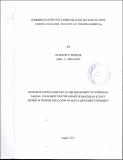| dc.description.abstract | Older adults constitute a majority and a growing proportion of people who receive nursing care in Kenya. It's projected that by 2050; there will be a 470% increase in the number of older persons, representing 10% of the Kenyan population. This projected increase calls for action by the government because it's likely to pose a challenge to the health care system if tomorrow's nurses are not adequately equipped to communicate effectively with this generation. Though they are living longer, 80% of them have at least two chronic conditions known to cause communication problems. However, research findings indicate that the quality of nurse-older person communication has been and continues to be poor. Barriers to effective communication between student nurses and older patients are increasing their length of stay and resource use, eroding the quality of nursing care. The purpose of this descriptive research study was to examine the barriers to effective communication, determine how students and older patients perceive their communication and explore ways of improving communication between student nurses and older patients. This is relevant as today's Nursing students are tomorrow's registered nurses and the manner in which they currently communicate with older persons may indicate how they will interact with them in future. Simple random sampling technique was used to select a total sample size of 172 (patients n=84 and student nurses n=88) participants from Chogoria Hospital and Nursing Training School. Data was collected from the subjects using a questionnaire for both students and patients. Data was analyzed using statistical package for social sciences (SPSS) software version 17.0. The respondents acknowledged that there were barriers to effective communication. Fifty-four (64.3%) of the patients and 84 (95%) of the students asserted that age-related changes affected communication, 66 (78.6%) of the patients and 76 (87.4%) of the students believed that there was the need for additional information. It was found out that Eighty-three (98.8%) of the patients and 76 (87.4%) of the students thought that attachment of the students to qualified Registered Nurses would boost communication. These results expand our understanding of the barriers to effective communication between Nursing students and older patients. These insights will be used in training to reinforce a positive attitude of student nurses with regards to effective communication with older patients, improving the quality of nursing care. In subsequent research, these findings will be used to study faculty members' attitudes towards older patients since their attitudes have been found in studies to affect their students' attitudes. | en_US |

